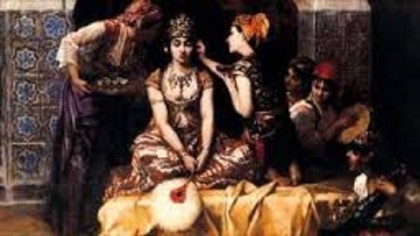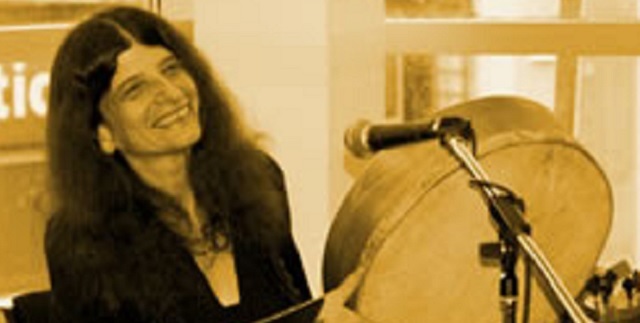EMPEZAR QUIERO CONTAR, CON JUDITH COHEN – Hoy escucharemos unas canciones de las circunstancias de la vida cotidiana. A finales del siglo XIX y principios del siglo XX muchos sefardíes, tanto en el antiguo imperio otomano como en Marruecos, tenían a su alcance no solamente sus canciones de siempre y la música de su entorno, sino también las nuevas modas de España, de Francia, de Argentina, Brasil, etc. Además, aparecían las primeras grabaciones comerciales y la radio, con una riqueza enorme de posibilidades musicales. En aquella época, hasta la Segunda Guerra Mundial, los sefardíes iban creando nuevas canciones en judeoespañol, con frecuencia adaptando temas de todas estas fuentes musicales. Un año en Israel, conocí a un grupo de mujeres que se llamaban “Las Amigas” y que se reunían cada lunes para hablar y cantar en judeoespañol. Entre ellas estaba Berta Aguado, que conocí por primera vez en aquel momento. “Las amigas” habían compuesto nuevas letras – muevos vyerbos –con la melodía de la canción sefardí “Alta alta va la luna”. Empezaban cada encuentro con esta canción.
Los sefardíes apreciaban mucho la cultura francesa. Aquí, las Estreyikas d’Estambol, dirigidos por mi amigo Izzet Baná, cantan la buena vida en Marsella, Marsiliya.
En el anterior programa escuchábamos canciones románticas de amor. En ésta, las cosas se ponen más prosaicas: se le explica al joven que debe buscarse a una mujer que sea buena ama de casa. Grabé esta versión de “Toma muzher menajera” en Salónica en 1991, de Bienvenida Mano. La melodía es de una canción popular francesa.
No solamente las melodías de Francia sino de muchas más culturas fueron adaptadas al nuevo cancionero sefardí. El foxtrot, el tango, el charlestón, el rebétiko griego: todos aparecieron con letras en judeoespañol, en muchos casos compuestas por el dúo de Salónica conocido como “Sadik y Gazós”. Aquí “Las Amigas”, a las que hemos escuchado hace unos minutos, cantan un “charlestón” en una mezcla de judeoespañol y francés.
Bouena Sarfaty Garfinkle, de Salónica y Montreal, me dijo que la canción siguiente era “una canción antigua de Estambul”. Pero los orígenes de esta canción son un poco más complicados. Era una canción en francés, “C’est la danse nouvelle” – el nuevo baile, la danse nouvelle – pero ¿de qué baile nuevo se trataba? Pues la matchitche, machicha o maxixe de Brasil, muy popular en los últimos años del siglo XIX y principio del XX. Bouena cantaba el estribillo en francés, siguiendo la versión de Francia, “allons doucement, changeons le cavalier”. Janet y Jak Esim, de Turquía, también lo cantan en francés. Pero Los Pasharos Sefardis cantan esta misma frase con palabras turcas que imitan el sonido del francés – “amán dushmán” en vez de “allons doucement”, imitando, quizás inconscientemente, la práctica sefardí de componer contrafacta en hebreo de textos en judeoespañol, procurando que el texto en hebreo tenga una resonancia parecida a las letras en judeoespañol. Escuchemos un poquito de cada uno – a Bouena Sarfaty Garifnkle, a Janet y Jak Esim y a Los Pasharos Sefardis.
Entre los sefardíes de Marruecos había una costumbre que todavía se practica en los pueblos de España: el paseo de la tarde por la avenida central. En esta canción, que cantábamos con Gerineldo, el paseo es por la avenida central de Tánger. Las letras se burlan de los que decían que tenían mehná del figado – problemas de hígado – porque querían ir a Lanjarón para tomar las aguas; se burla de las nuevas luces de neón, de las nuevas modas de vestirse de las al’azbas, las muchachas – bushcando a novio, etc. El estribillo incluye la frase “me vaya kapará”, de la expresión “me vaya kapará por ti”, con la palabra hebreo “kapará”. Soly Lévy añadió una estrofa hablando de nuestro invierno canadiense – y por cierto, mientras os hablo, estamos todavía con nieve….
Sin salir de Marruecos, también con Gerineldo, cantábamos “Pescado frito vende Ya’akov” – y podéis imaginar lo que son la “sartén” de la muchacha que se llama Mazaltó, lo que es su horno – o forno – y su fedán, su huerta. Se canta en haketía, con palabras adaptadas del árabe, como “hame’ar”, calentar – el forno…..
Otra metáfora para actividades parecidas aparece en la canción “Encalador”. Cuando llegaba el momento de encalar las casas, de blanquearlas con cal, llegaba el encalador y llamaba a las puertas de las amas de casa. Es una contrafacta de la canción turca “Osman Aga”, cantada aquí por David Saltiel de Salónica.
Tanto entre los sefardíes del norte de Marruecos, como en España, los cuplés eran muy apreciados. El famoso “El relicario”, cantado por Sara Montiel entre otros, prestó su melodía a esta queja en haketía, de la joven Jolita, o Raquel – contando que todos los chicos emigraban de Marruecos y no quedaba con quién casarse. La canta aquí Avraham Sarfati de Tetuán, grabado en Israel con el Proyecto Folklor. Podréis escuchar palabras en hebreo y en árabe; “Timimona” es la mimuna que se celebra en Marruecos al terminar la pascua judía.
Otra Jolita: un año que fuimos con Gerineldo a cantar en Nueva York, nuestra directora Oro Anahory-Librowicz nos presentó a Flora Ohana de Roublev. Escuchemos unos momentos divertidos de aquel encuentro.
“Es el ritmo que tiene gracia”, dijo Flora. Pues ahora, volviendo a Turquía, en esta canción divertida es también el ritmo que tiene gracia – el ritmo popular turco y búlgaro de 9 pulsos (2-2-2-3) . Las letras inventan unas actividades de fantasía de los animalitos, y el estribillo, en turco, dice “te quiero mucho”. La cantan mis amigos Los Pasharos Sefardís, de Estambul.
Muchas canciones en ídish hablan de los duros trabajos de la revolución industrial y de las largas horas de trabajo en las fábricas, o de la sastrería. Este género de canción de trabajo, por razones históricas, no existe en la tradición sefardí, pero cuando lo comenté hace años en Estambul con el jefe de coro Yeshua Aroyo, me cantó esta cancioncilla que habla justamente de la máquina de coser.
Una actividad cotidiana universal es ir de compras a buscar la comida del día. Esta canción de principios del siglo XX es una adaptación de una canción acumulativa infantil de Francia. Pero en esta versión en judeoespañol, Madame Gaspard no va au marché, ni tampoco al mercado, sino que va al charsi, la palabra turca. Esta grabación es del año 1910; me la facilitó el investigador Martin Schwartz. Canta Jacob Algava. Y con estas compras acumulativas de Mme Gaspard en el charshi, acabamos el programa de hoy. En el próximo, que será el último de la serie, escucharemos algunas canciones serias, de tragedias, y otras que cantan la esperanza.. Hasta entonces, saludos desde Canadá, a todos los de Radio Sefarad, y a todos vosotros oyentes, de vuestra amiga Judith Cohen.
[TEXT IN ENGLISH:
EMPEZAR QUIERO CONTAR, WITH JUDITH COHEN – 6. Songs of daily life
Today we’ll listen to some songs about daily life. In the late 19th and early 20th centuries, many Sephardim in both the Ottoman regions and in Morocco ad a wide range of music available to them: not only their traditional songs and the music of the area where they lived, but, as well, the new musical fashions of Spain, France, Argentina, Brazil and more. In the first years of the 20th century, the recording industry appeared, with its enormous possibilities. During those years, up to World War II, Sephardim also created new songs in Judeo-Spanish, often adapting melodies from both old and new sources. One year in Israel, I met a group of women called “The Friends” (Las Amigas) who met every Monday to speak and sing in Judeo-Spanish. They’d composed new lyrics – muevos vyerbos –to the tune of Sephardic song “Alta alta va la luna” (“High, high, rises the moon”), and began each meeting with this new song.
Sephardim were often especially fond of French culture. Here, the children’s choir “las Estreyikas d’Estambol”(“The Little Stars of Istanbul”), directed by my good friend Izzet Baná, sing about the good life in Marseilles, or Marsiliya.
In the last programme, we listened to some romantic love songs. Here, things are a little more prosaic: a young bachelor is advised to look for a wife who will be a good housekeeper. I recorded this version of “Toma muzher menajera” in Salónica in 1991, from Bienvenida Mano. The melody is from a popular French song.
Tunes from many other cultures were also adapted, to new lyrics in Judeo-Spanish. Foxtrot, tango, charleston, rebetiko: all appeared with new Judeo-Spanish words, often composed by the Salonica duo known as “Sadik y Gazós”. Here “Las Amigas”, to whom we listened just a few minutes ago, sing a “charlestón” in an insouciant mixture of Judeo-Spanish and French.
Bouena Sarfaty Garfinkle, from Salónica and Montreal, told me that the next song was “an ancient song of Istanbul”, but really its origin are more complicated. It was a song in French, “C’est la danse nouvelle” – the “new dance”, la danse nouvelle – but which “new dance” was this? It was the matchitche, machicha or maxixe of Brazil, very popular in the last years of the 19th century and the beginning of the 20th. Bouena sang the refrain in French, following the version popular in France: “allons doucement, changeons le cavalier”. Janet and Jak Esim, of Turkey, also sing the refrain in French. But Los Pasharos Sefardis sing this same phrase with Turkish words which imitate the sound of the French words: “amán dushmán” instead of “allons doucement”, which, in turns imitates, perhaps unconsciously, the Sephardic technique of composing Judeo-Spanish lyrics as contrafacta of Hebrew texts. Let’s listen to a bit of each version: Bouena Sarfatty Garfinkle, Janet and Jak Esim, and Los Pasharos Sefardis.
The Sephardim in Morocco had a custom also found in most Spanish towns: strolling along the central avenue in the early evening. In this song, which I often sang with our group Gerineldo, this stroll takes place in Tangier. The words poke fun at people who went to Lanjarón (in Andalusia) to take the waters for their mehná del figado – liver ailments –; makes fun of the new neon lights, the current fashions worn by the girls, the al’azbas in haketía, bushcando a novio , checking out possible boyfriends, and some on. The refrain includes the phrase “me vaya kapará”, from the expression “me vaya kapará por ti”, with the Hebrew word “kapará”. Solly Lévy used to add his own stanza about our Canadian winters.
Still in Morocco, and still with Gerineldo, we sang “Pescado frito vende Ya’akov” – “Jacob sells fresh fish.” You can imagine the double meanings implied by the girl Mazaltó’s “frying pan”, and her “oven”, forno – and her fedán, her garden. It’s sung in haketía, with words adapted from local Arabic, such as “hame’ar”, to heat up (the oven).
Another domestic metaphor appears in a Salonica song about a whitewasher, “Encalador”. When houses needed to be whitewashed, in the old way, with lime, “cal”, the “lime-applier” (encalador) would knock on neighbourhood doors, and the housewives would let him in. This is a contrafactum of the popular Turkish song “Osman Aga”, sung by David Saltiel of Salónica.
Sephardim in northern Morocco, under the Spanish Protectorate, shared the Spanish affection for the song genre known as the cuplé. The famous “El relicario”, sung by Sara Montiel, among others, loaned its melody to this complaint in haketía: young Jolita, or
Raquel, sings that all the eligible boys have emigrated from Morocco and there’s no one left to marry. Here it’s sung Avraham Sarfati of Tetuán, recorded in Israel by Proyecto Folklor. You can hear some words in Hebrew and in local Arabic: Timimona is mimuna, celebrated by Moroccan Jews at the end of the eight days of Passover.
Another Jolita: one year, when Gerineldo went to sing in new York City, our founder-director, Oro Anahory-Librowicz, took us to meet Flora Ohana de Roublev. Let’s listen to a couple of minutes from that delightful session. “It’s the rhythm that provides the charm”, said Flora. And now, returning to Turkey, in this amusing ditty it’s also the rhythm which provides the charm: it’s a very popular Turkish and Bulgarian rhythmic pattern in nine: 2 + 2+ 2+ 3. The lyrics invent unlikely activities carried out by various animals, starting with the frog, and the refrain, in Turkish, repeats “I love you a lot.” Let’s listen to “Si veriash a la rana”, sung by my friends Los Pasharos Sefardís, of Estambul.
Many Yiddish songs describe the punishing work of new jobs which emerged iduring the Industrial Revolution, including the long hours both men and women worked in factories, and often as tailors or seamstresses. For historical reasons, this song genre doesn’t exist in the Sephardic repertoire. Still, one day when I was talking about this with the Istanbul Sephardic choir director Yeshua Aroyo, me sang me a little song about a young woman sitting at her sewing machine.
A universal daily task is acquiring and preparing daily food. This song from the beginning of the 20th century is an adaptation of a French children’s song, in cumulative form. In this Judeo-Spanish version, Madame Gaspard continues to be called Madame and not Sinyora, but rather than going to the market, the mercado or marché, she goes to the charsi, the Turkish word. This is sung by Jacob Algava, in a recording from the year 1910, graciously sent to me by the researcher Martin Schwartz. And with these cumulative purchases of Madame Gaspard in the charshi, we’ll wind up today’s programme. The next one will be the last one of this series, and we’ll hear songs of despair, songs of hopelessness – and songs of hope. Till then, greetings from Canada to everyone at Radio Sefarad and all you listeners, from your friend Judith Cohen in Canada.]




